Finance and Funding: Decision Making in Travel and Tourism Sector
VerifiedAdded on 2024/04/25
|20
|6067
|213
Report
AI Summary
This report delves into the critical aspects of finance and funding within the travel and tourism sector, highlighting the significance of cost, volume, and profit in management decision-making. It analyzes pricing approaches, factors influencing profitability, and the application of management accounting information in tourism businesses, using examples from companies like Dalata Hotel Group Plc and Carnival Corporation & Plc. The report further interprets financial accounts to aid decision-making and examines funding sources and distribution for both public and non-public tourism development, providing a comprehensive overview of financial strategies and considerations in the tourism industry. Desklib provides access to similar solved assignments and past papers for students.
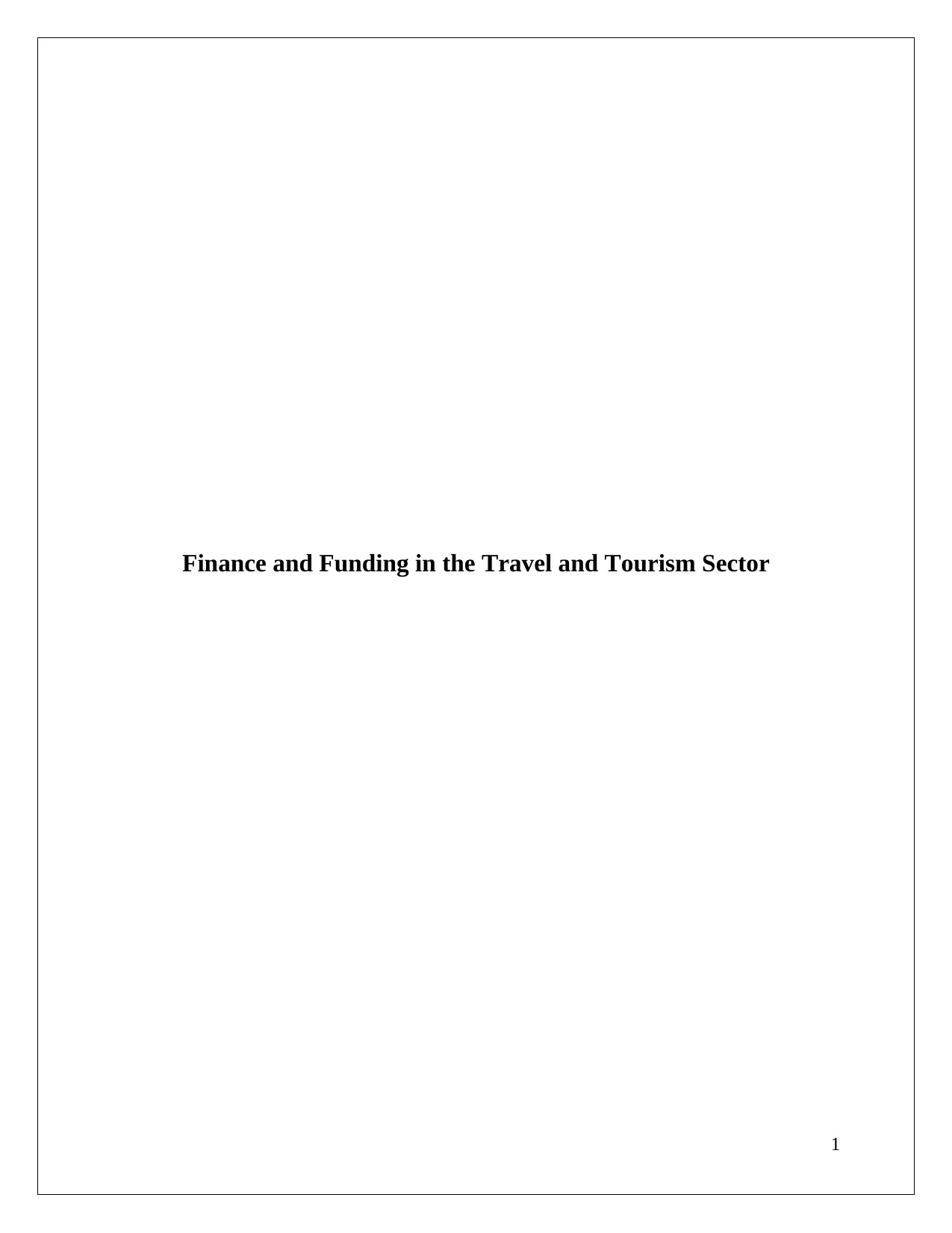
Finance and Funding in the Travel and Tourism Sector
1
1
Paraphrase This Document
Need a fresh take? Get an instant paraphrase of this document with our AI Paraphraser
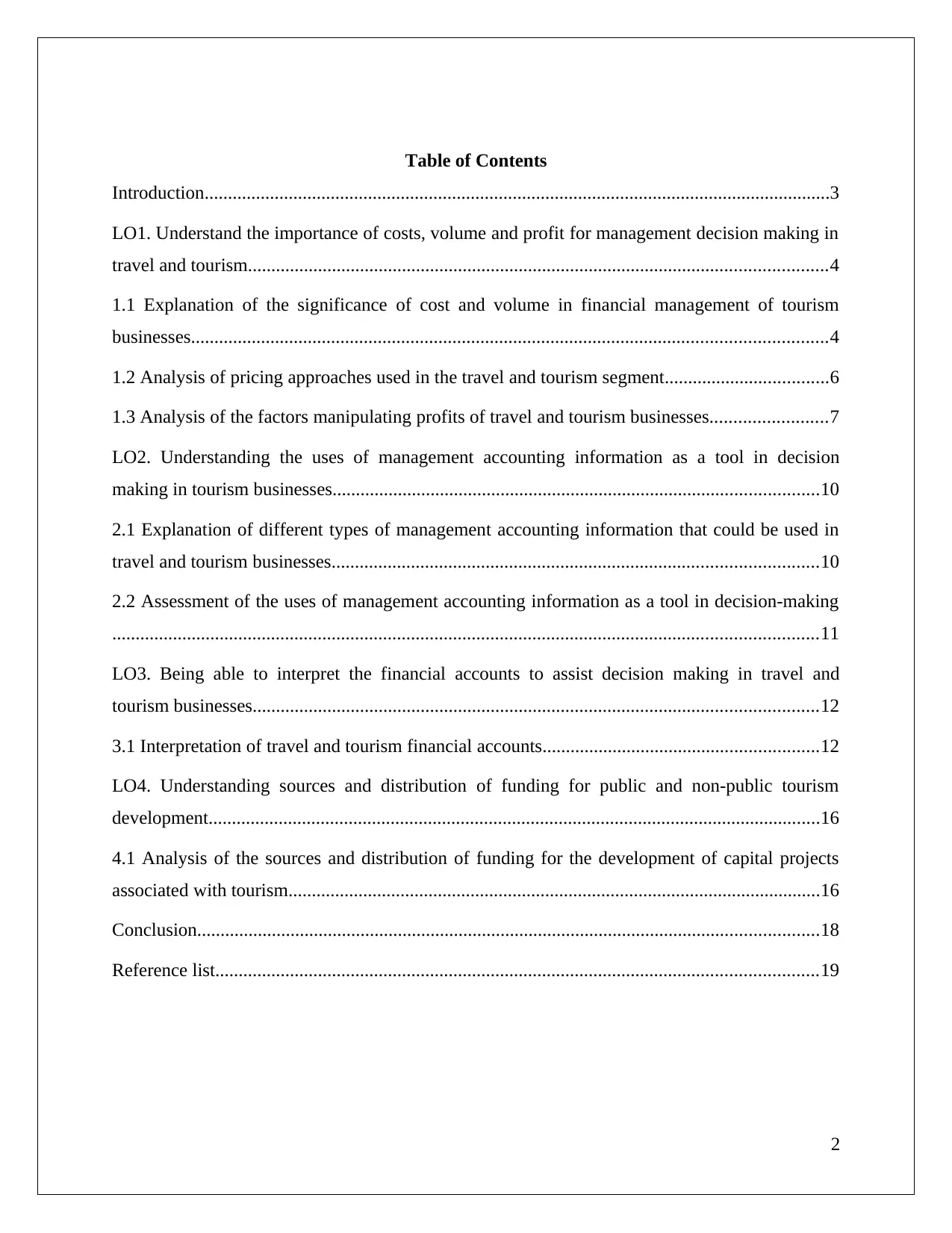
Table of Contents
Introduction......................................................................................................................................3
LO1. Understand the importance of costs, volume and profit for management decision making in
travel and tourism............................................................................................................................4
1.1 Explanation of the significance of cost and volume in financial management of tourism
businesses........................................................................................................................................4
1.2 Analysis of pricing approaches used in the travel and tourism segment...................................6
1.3 Analysis of the factors manipulating profits of travel and tourism businesses.........................7
LO2. Understanding the uses of management accounting information as a tool in decision
making in tourism businesses........................................................................................................10
2.1 Explanation of different types of management accounting information that could be used in
travel and tourism businesses........................................................................................................10
2.2 Assessment of the uses of management accounting information as a tool in decision-making
.......................................................................................................................................................11
LO3. Being able to interpret the financial accounts to assist decision making in travel and
tourism businesses.........................................................................................................................12
3.1 Interpretation of travel and tourism financial accounts...........................................................12
LO4. Understanding sources and distribution of funding for public and non-public tourism
development...................................................................................................................................16
4.1 Analysis of the sources and distribution of funding for the development of capital projects
associated with tourism..................................................................................................................16
Conclusion.....................................................................................................................................18
Reference list.................................................................................................................................19
2
Introduction......................................................................................................................................3
LO1. Understand the importance of costs, volume and profit for management decision making in
travel and tourism............................................................................................................................4
1.1 Explanation of the significance of cost and volume in financial management of tourism
businesses........................................................................................................................................4
1.2 Analysis of pricing approaches used in the travel and tourism segment...................................6
1.3 Analysis of the factors manipulating profits of travel and tourism businesses.........................7
LO2. Understanding the uses of management accounting information as a tool in decision
making in tourism businesses........................................................................................................10
2.1 Explanation of different types of management accounting information that could be used in
travel and tourism businesses........................................................................................................10
2.2 Assessment of the uses of management accounting information as a tool in decision-making
.......................................................................................................................................................11
LO3. Being able to interpret the financial accounts to assist decision making in travel and
tourism businesses.........................................................................................................................12
3.1 Interpretation of travel and tourism financial accounts...........................................................12
LO4. Understanding sources and distribution of funding for public and non-public tourism
development...................................................................................................................................16
4.1 Analysis of the sources and distribution of funding for the development of capital projects
associated with tourism..................................................................................................................16
Conclusion.....................................................................................................................................18
Reference list.................................................................................................................................19
2
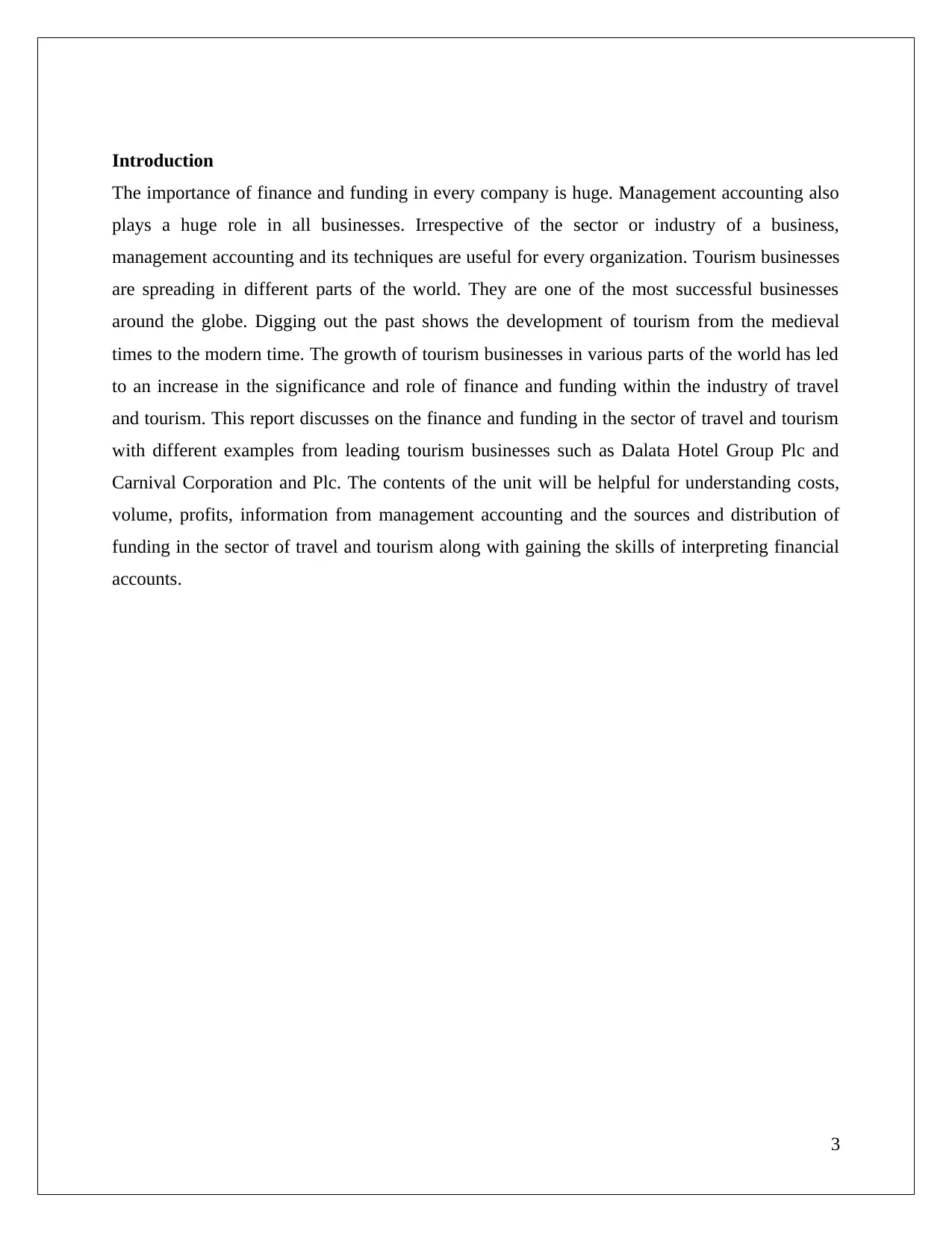
Introduction
The importance of finance and funding in every company is huge. Management accounting also
plays a huge role in all businesses. Irrespective of the sector or industry of a business,
management accounting and its techniques are useful for every organization. Tourism businesses
are spreading in different parts of the world. They are one of the most successful businesses
around the globe. Digging out the past shows the development of tourism from the medieval
times to the modern time. The growth of tourism businesses in various parts of the world has led
to an increase in the significance and role of finance and funding within the industry of travel
and tourism. This report discusses on the finance and funding in the sector of travel and tourism
with different examples from leading tourism businesses such as Dalata Hotel Group Plc and
Carnival Corporation and Plc. The contents of the unit will be helpful for understanding costs,
volume, profits, information from management accounting and the sources and distribution of
funding in the sector of travel and tourism along with gaining the skills of interpreting financial
accounts.
3
The importance of finance and funding in every company is huge. Management accounting also
plays a huge role in all businesses. Irrespective of the sector or industry of a business,
management accounting and its techniques are useful for every organization. Tourism businesses
are spreading in different parts of the world. They are one of the most successful businesses
around the globe. Digging out the past shows the development of tourism from the medieval
times to the modern time. The growth of tourism businesses in various parts of the world has led
to an increase in the significance and role of finance and funding within the industry of travel
and tourism. This report discusses on the finance and funding in the sector of travel and tourism
with different examples from leading tourism businesses such as Dalata Hotel Group Plc and
Carnival Corporation and Plc. The contents of the unit will be helpful for understanding costs,
volume, profits, information from management accounting and the sources and distribution of
funding in the sector of travel and tourism along with gaining the skills of interpreting financial
accounts.
3
⊘ This is a preview!⊘
Do you want full access?
Subscribe today to unlock all pages.

Trusted by 1+ million students worldwide
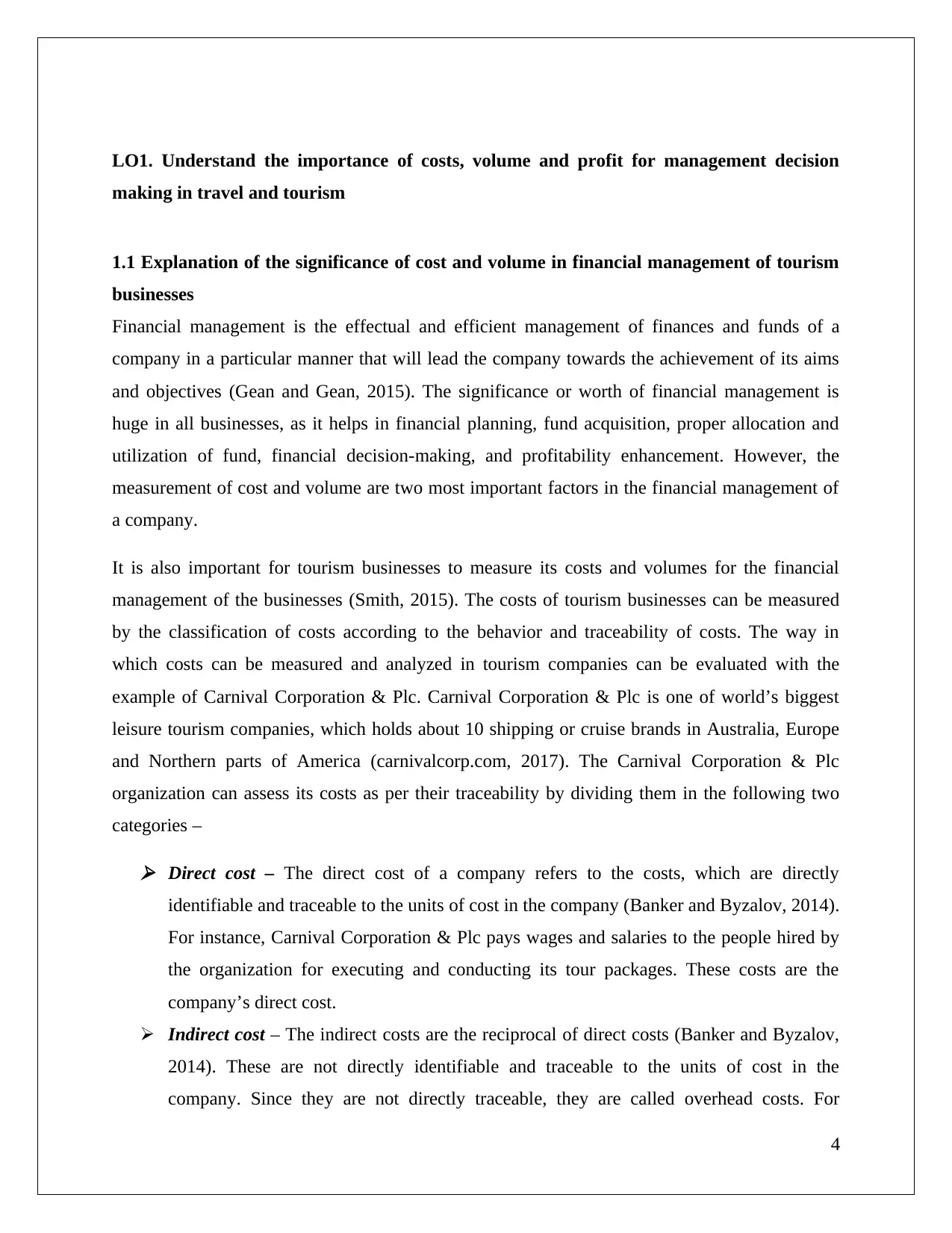
LO1. Understand the importance of costs, volume and profit for management decision
making in travel and tourism
1.1 Explanation of the significance of cost and volume in financial management of tourism
businesses
Financial management is the effectual and efficient management of finances and funds of a
company in a particular manner that will lead the company towards the achievement of its aims
and objectives (Gean and Gean, 2015). The significance or worth of financial management is
huge in all businesses, as it helps in financial planning, fund acquisition, proper allocation and
utilization of fund, financial decision-making, and profitability enhancement. However, the
measurement of cost and volume are two most important factors in the financial management of
a company.
It is also important for tourism businesses to measure its costs and volumes for the financial
management of the businesses (Smith, 2015). The costs of tourism businesses can be measured
by the classification of costs according to the behavior and traceability of costs. The way in
which costs can be measured and analyzed in tourism companies can be evaluated with the
example of Carnival Corporation & Plc. Carnival Corporation & Plc is one of world’s biggest
leisure tourism companies, which holds about 10 shipping or cruise brands in Australia, Europe
and Northern parts of America (carnivalcorp.com, 2017). The Carnival Corporation & Plc
organization can assess its costs as per their traceability by dividing them in the following two
categories –
Direct cost – The direct cost of a company refers to the costs, which are directly
identifiable and traceable to the units of cost in the company (Banker and Byzalov, 2014).
For instance, Carnival Corporation & Plc pays wages and salaries to the people hired by
the organization for executing and conducting its tour packages. These costs are the
company’s direct cost.
Indirect cost – The indirect costs are the reciprocal of direct costs (Banker and Byzalov,
2014). These are not directly identifiable and traceable to the units of cost in the
company. Since they are not directly traceable, they are called overhead costs. For
4
making in travel and tourism
1.1 Explanation of the significance of cost and volume in financial management of tourism
businesses
Financial management is the effectual and efficient management of finances and funds of a
company in a particular manner that will lead the company towards the achievement of its aims
and objectives (Gean and Gean, 2015). The significance or worth of financial management is
huge in all businesses, as it helps in financial planning, fund acquisition, proper allocation and
utilization of fund, financial decision-making, and profitability enhancement. However, the
measurement of cost and volume are two most important factors in the financial management of
a company.
It is also important for tourism businesses to measure its costs and volumes for the financial
management of the businesses (Smith, 2015). The costs of tourism businesses can be measured
by the classification of costs according to the behavior and traceability of costs. The way in
which costs can be measured and analyzed in tourism companies can be evaluated with the
example of Carnival Corporation & Plc. Carnival Corporation & Plc is one of world’s biggest
leisure tourism companies, which holds about 10 shipping or cruise brands in Australia, Europe
and Northern parts of America (carnivalcorp.com, 2017). The Carnival Corporation & Plc
organization can assess its costs as per their traceability by dividing them in the following two
categories –
Direct cost – The direct cost of a company refers to the costs, which are directly
identifiable and traceable to the units of cost in the company (Banker and Byzalov, 2014).
For instance, Carnival Corporation & Plc pays wages and salaries to the people hired by
the organization for executing and conducting its tour packages. These costs are the
company’s direct cost.
Indirect cost – The indirect costs are the reciprocal of direct costs (Banker and Byzalov,
2014). These are not directly identifiable and traceable to the units of cost in the
company. Since they are not directly traceable, they are called overhead costs. For
4
Paraphrase This Document
Need a fresh take? Get an instant paraphrase of this document with our AI Paraphraser
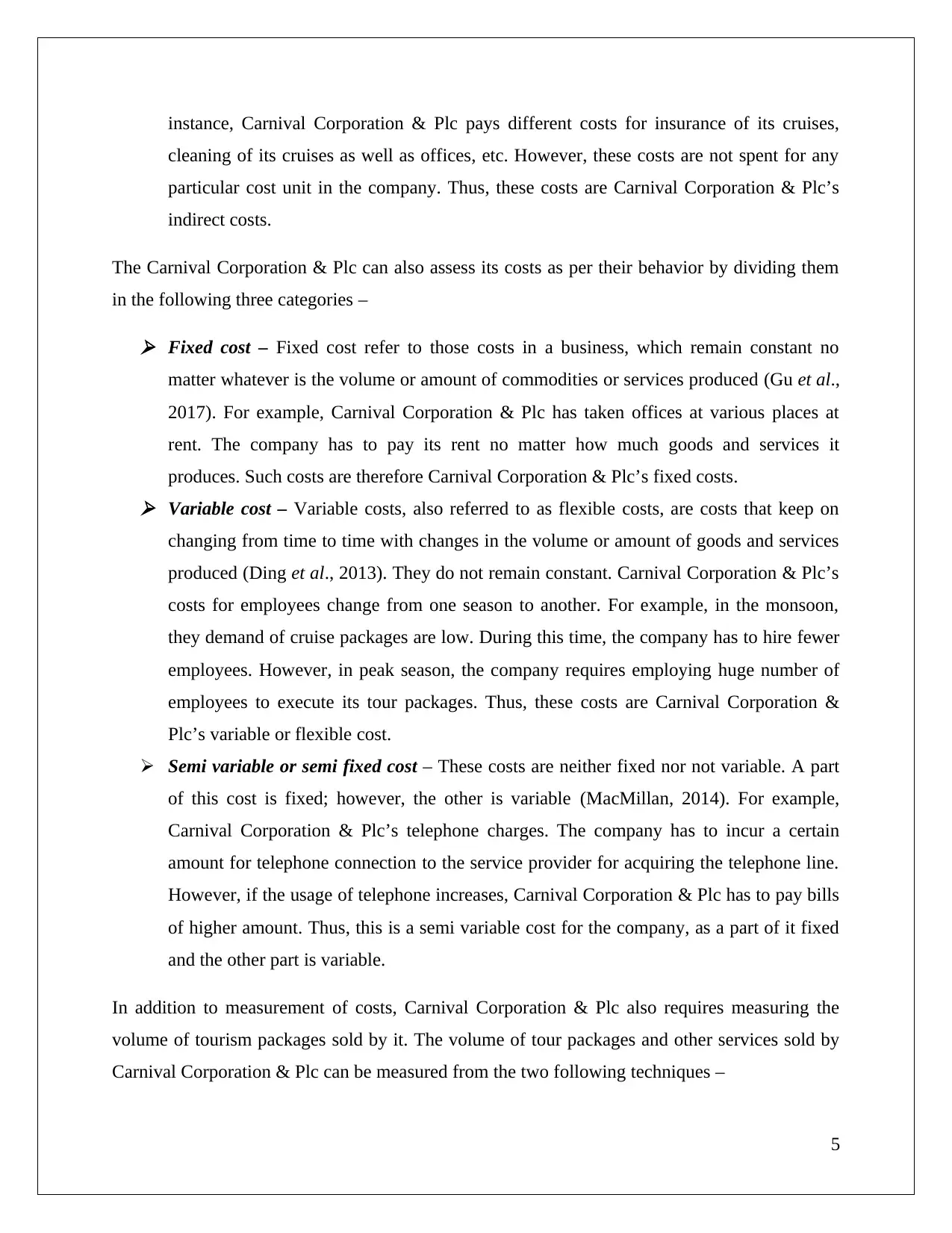
instance, Carnival Corporation & Plc pays different costs for insurance of its cruises,
cleaning of its cruises as well as offices, etc. However, these costs are not spent for any
particular cost unit in the company. Thus, these costs are Carnival Corporation & Plc’s
indirect costs.
The Carnival Corporation & Plc can also assess its costs as per their behavior by dividing them
in the following three categories –
Fixed cost – Fixed cost refer to those costs in a business, which remain constant no
matter whatever is the volume or amount of commodities or services produced (Gu et al.,
2017). For example, Carnival Corporation & Plc has taken offices at various places at
rent. The company has to pay its rent no matter how much goods and services it
produces. Such costs are therefore Carnival Corporation & Plc’s fixed costs. Variable cost – Variable costs, also referred to as flexible costs, are costs that keep on
changing from time to time with changes in the volume or amount of goods and services
produced (Ding et al., 2013). They do not remain constant. Carnival Corporation & Plc’s
costs for employees change from one season to another. For example, in the monsoon,
they demand of cruise packages are low. During this time, the company has to hire fewer
employees. However, in peak season, the company requires employing huge number of
employees to execute its tour packages. Thus, these costs are Carnival Corporation &
Plc’s variable or flexible cost.
Semi variable or semi fixed cost – These costs are neither fixed nor not variable. A part
of this cost is fixed; however, the other is variable (MacMillan, 2014). For example,
Carnival Corporation & Plc’s telephone charges. The company has to incur a certain
amount for telephone connection to the service provider for acquiring the telephone line.
However, if the usage of telephone increases, Carnival Corporation & Plc has to pay bills
of higher amount. Thus, this is a semi variable cost for the company, as a part of it fixed
and the other part is variable.
In addition to measurement of costs, Carnival Corporation & Plc also requires measuring the
volume of tourism packages sold by it. The volume of tour packages and other services sold by
Carnival Corporation & Plc can be measured from the two following techniques –
5
cleaning of its cruises as well as offices, etc. However, these costs are not spent for any
particular cost unit in the company. Thus, these costs are Carnival Corporation & Plc’s
indirect costs.
The Carnival Corporation & Plc can also assess its costs as per their behavior by dividing them
in the following three categories –
Fixed cost – Fixed cost refer to those costs in a business, which remain constant no
matter whatever is the volume or amount of commodities or services produced (Gu et al.,
2017). For example, Carnival Corporation & Plc has taken offices at various places at
rent. The company has to pay its rent no matter how much goods and services it
produces. Such costs are therefore Carnival Corporation & Plc’s fixed costs. Variable cost – Variable costs, also referred to as flexible costs, are costs that keep on
changing from time to time with changes in the volume or amount of goods and services
produced (Ding et al., 2013). They do not remain constant. Carnival Corporation & Plc’s
costs for employees change from one season to another. For example, in the monsoon,
they demand of cruise packages are low. During this time, the company has to hire fewer
employees. However, in peak season, the company requires employing huge number of
employees to execute its tour packages. Thus, these costs are Carnival Corporation &
Plc’s variable or flexible cost.
Semi variable or semi fixed cost – These costs are neither fixed nor not variable. A part
of this cost is fixed; however, the other is variable (MacMillan, 2014). For example,
Carnival Corporation & Plc’s telephone charges. The company has to incur a certain
amount for telephone connection to the service provider for acquiring the telephone line.
However, if the usage of telephone increases, Carnival Corporation & Plc has to pay bills
of higher amount. Thus, this is a semi variable cost for the company, as a part of it fixed
and the other part is variable.
In addition to measurement of costs, Carnival Corporation & Plc also requires measuring the
volume of tourism packages sold by it. The volume of tour packages and other services sold by
Carnival Corporation & Plc can be measured from the two following techniques –
5
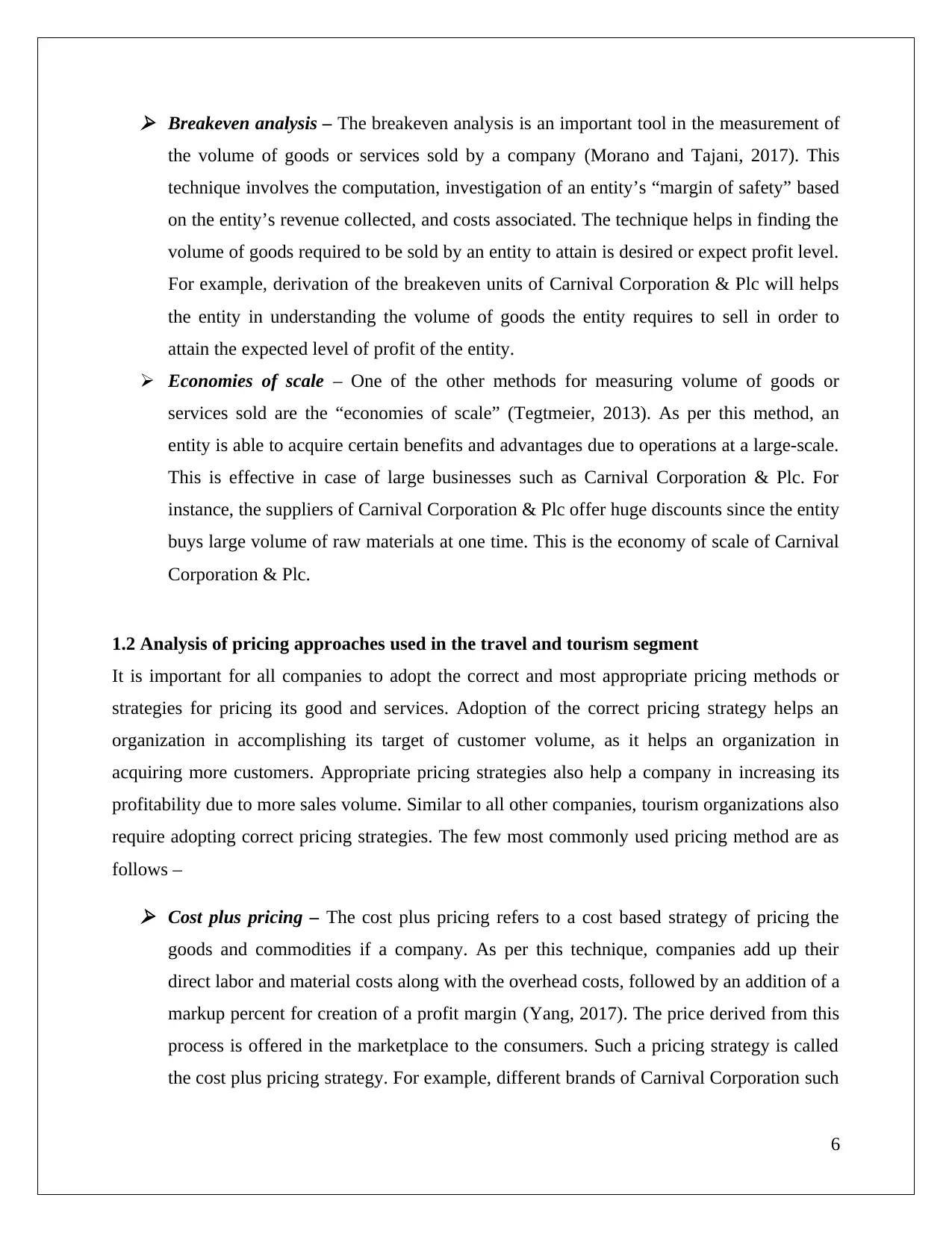
Breakeven analysis – The breakeven analysis is an important tool in the measurement of
the volume of goods or services sold by a company (Morano and Tajani, 2017). This
technique involves the computation, investigation of an entity’s “margin of safety” based
on the entity’s revenue collected, and costs associated. The technique helps in finding the
volume of goods required to be sold by an entity to attain is desired or expect profit level.
For example, derivation of the breakeven units of Carnival Corporation & Plc will helps
the entity in understanding the volume of goods the entity requires to sell in order to
attain the expected level of profit of the entity.
Economies of scale – One of the other methods for measuring volume of goods or
services sold are the “economies of scale” (Tegtmeier, 2013). As per this method, an
entity is able to acquire certain benefits and advantages due to operations at a large-scale.
This is effective in case of large businesses such as Carnival Corporation & Plc. For
instance, the suppliers of Carnival Corporation & Plc offer huge discounts since the entity
buys large volume of raw materials at one time. This is the economy of scale of Carnival
Corporation & Plc.
1.2 Analysis of pricing approaches used in the travel and tourism segment
It is important for all companies to adopt the correct and most appropriate pricing methods or
strategies for pricing its good and services. Adoption of the correct pricing strategy helps an
organization in accomplishing its target of customer volume, as it helps an organization in
acquiring more customers. Appropriate pricing strategies also help a company in increasing its
profitability due to more sales volume. Similar to all other companies, tourism organizations also
require adopting correct pricing strategies. The few most commonly used pricing method are as
follows –
Cost plus pricing – The cost plus pricing refers to a cost based strategy of pricing the
goods and commodities if a company. As per this technique, companies add up their
direct labor and material costs along with the overhead costs, followed by an addition of a
markup percent for creation of a profit margin (Yang, 2017). The price derived from this
process is offered in the marketplace to the consumers. Such a pricing strategy is called
the cost plus pricing strategy. For example, different brands of Carnival Corporation such
6
the volume of goods or services sold by a company (Morano and Tajani, 2017). This
technique involves the computation, investigation of an entity’s “margin of safety” based
on the entity’s revenue collected, and costs associated. The technique helps in finding the
volume of goods required to be sold by an entity to attain is desired or expect profit level.
For example, derivation of the breakeven units of Carnival Corporation & Plc will helps
the entity in understanding the volume of goods the entity requires to sell in order to
attain the expected level of profit of the entity.
Economies of scale – One of the other methods for measuring volume of goods or
services sold are the “economies of scale” (Tegtmeier, 2013). As per this method, an
entity is able to acquire certain benefits and advantages due to operations at a large-scale.
This is effective in case of large businesses such as Carnival Corporation & Plc. For
instance, the suppliers of Carnival Corporation & Plc offer huge discounts since the entity
buys large volume of raw materials at one time. This is the economy of scale of Carnival
Corporation & Plc.
1.2 Analysis of pricing approaches used in the travel and tourism segment
It is important for all companies to adopt the correct and most appropriate pricing methods or
strategies for pricing its good and services. Adoption of the correct pricing strategy helps an
organization in accomplishing its target of customer volume, as it helps an organization in
acquiring more customers. Appropriate pricing strategies also help a company in increasing its
profitability due to more sales volume. Similar to all other companies, tourism organizations also
require adopting correct pricing strategies. The few most commonly used pricing method are as
follows –
Cost plus pricing – The cost plus pricing refers to a cost based strategy of pricing the
goods and commodities if a company. As per this technique, companies add up their
direct labor and material costs along with the overhead costs, followed by an addition of a
markup percent for creation of a profit margin (Yang, 2017). The price derived from this
process is offered in the marketplace to the consumers. Such a pricing strategy is called
the cost plus pricing strategy. For example, different brands of Carnival Corporation such
6
⊘ This is a preview!⊘
Do you want full access?
Subscribe today to unlock all pages.

Trusted by 1+ million students worldwide
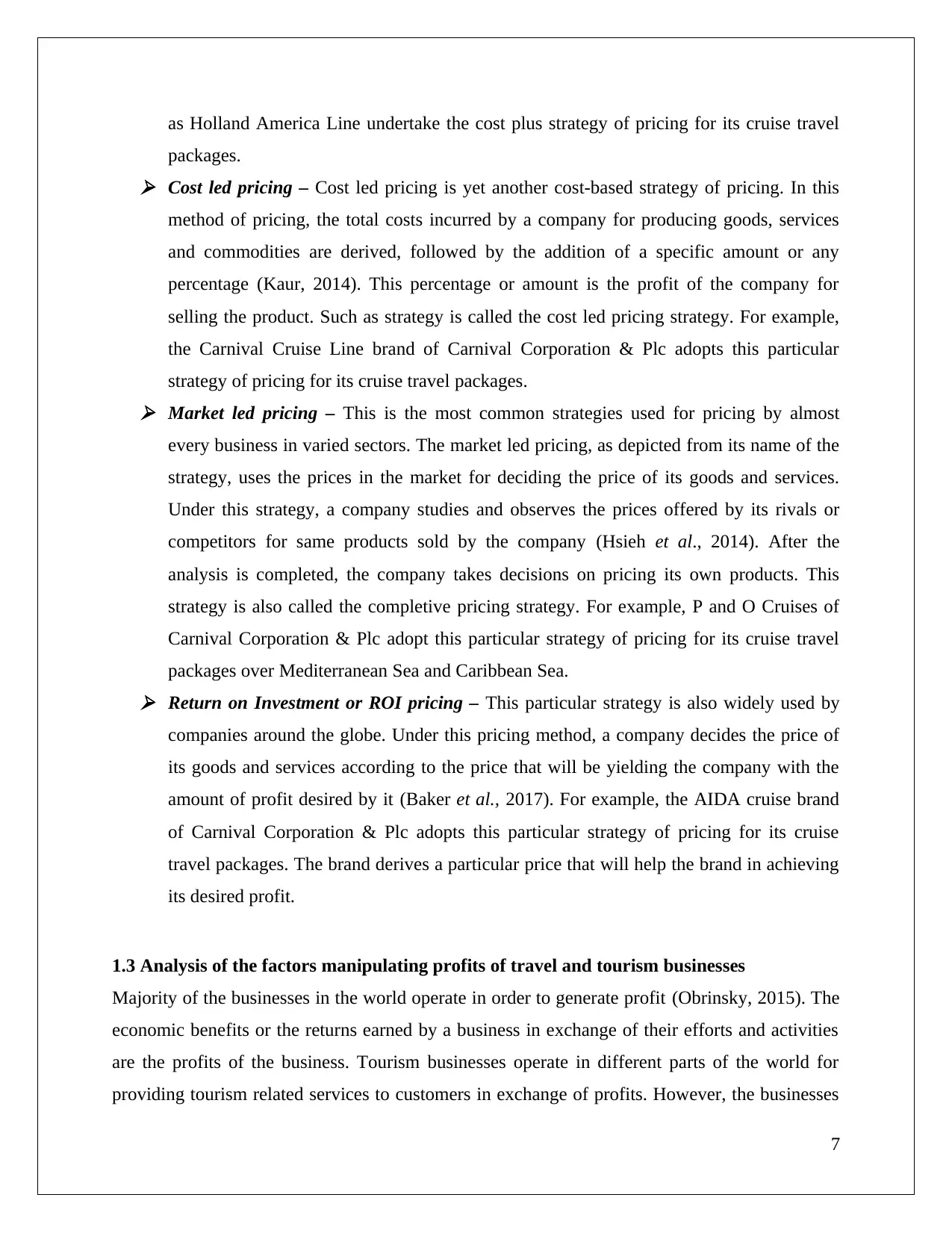
as Holland America Line undertake the cost plus strategy of pricing for its cruise travel
packages. Cost led pricing – Cost led pricing is yet another cost-based strategy of pricing. In this
method of pricing, the total costs incurred by a company for producing goods, services
and commodities are derived, followed by the addition of a specific amount or any
percentage (Kaur, 2014). This percentage or amount is the profit of the company for
selling the product. Such as strategy is called the cost led pricing strategy. For example,
the Carnival Cruise Line brand of Carnival Corporation & Plc adopts this particular
strategy of pricing for its cruise travel packages. Market led pricing – This is the most common strategies used for pricing by almost
every business in varied sectors. The market led pricing, as depicted from its name of the
strategy, uses the prices in the market for deciding the price of its goods and services.
Under this strategy, a company studies and observes the prices offered by its rivals or
competitors for same products sold by the company (Hsieh et al., 2014). After the
analysis is completed, the company takes decisions on pricing its own products. This
strategy is also called the completive pricing strategy. For example, P and O Cruises of
Carnival Corporation & Plc adopt this particular strategy of pricing for its cruise travel
packages over Mediterranean Sea and Caribbean Sea. Return on Investment or ROI pricing – This particular strategy is also widely used by
companies around the globe. Under this pricing method, a company decides the price of
its goods and services according to the price that will be yielding the company with the
amount of profit desired by it (Baker et al., 2017). For example, the AIDA cruise brand
of Carnival Corporation & Plc adopts this particular strategy of pricing for its cruise
travel packages. The brand derives a particular price that will help the brand in achieving
its desired profit.
1.3 Analysis of the factors manipulating profits of travel and tourism businesses
Majority of the businesses in the world operate in order to generate profit (Obrinsky, 2015). The
economic benefits or the returns earned by a business in exchange of their efforts and activities
are the profits of the business. Tourism businesses operate in different parts of the world for
providing tourism related services to customers in exchange of profits. However, the businesses
7
packages. Cost led pricing – Cost led pricing is yet another cost-based strategy of pricing. In this
method of pricing, the total costs incurred by a company for producing goods, services
and commodities are derived, followed by the addition of a specific amount or any
percentage (Kaur, 2014). This percentage or amount is the profit of the company for
selling the product. Such as strategy is called the cost led pricing strategy. For example,
the Carnival Cruise Line brand of Carnival Corporation & Plc adopts this particular
strategy of pricing for its cruise travel packages. Market led pricing – This is the most common strategies used for pricing by almost
every business in varied sectors. The market led pricing, as depicted from its name of the
strategy, uses the prices in the market for deciding the price of its goods and services.
Under this strategy, a company studies and observes the prices offered by its rivals or
competitors for same products sold by the company (Hsieh et al., 2014). After the
analysis is completed, the company takes decisions on pricing its own products. This
strategy is also called the completive pricing strategy. For example, P and O Cruises of
Carnival Corporation & Plc adopt this particular strategy of pricing for its cruise travel
packages over Mediterranean Sea and Caribbean Sea. Return on Investment or ROI pricing – This particular strategy is also widely used by
companies around the globe. Under this pricing method, a company decides the price of
its goods and services according to the price that will be yielding the company with the
amount of profit desired by it (Baker et al., 2017). For example, the AIDA cruise brand
of Carnival Corporation & Plc adopts this particular strategy of pricing for its cruise
travel packages. The brand derives a particular price that will help the brand in achieving
its desired profit.
1.3 Analysis of the factors manipulating profits of travel and tourism businesses
Majority of the businesses in the world operate in order to generate profit (Obrinsky, 2015). The
economic benefits or the returns earned by a business in exchange of their efforts and activities
are the profits of the business. Tourism businesses operate in different parts of the world for
providing tourism related services to customers in exchange of profits. However, the businesses
7
Paraphrase This Document
Need a fresh take? Get an instant paraphrase of this document with our AI Paraphraser
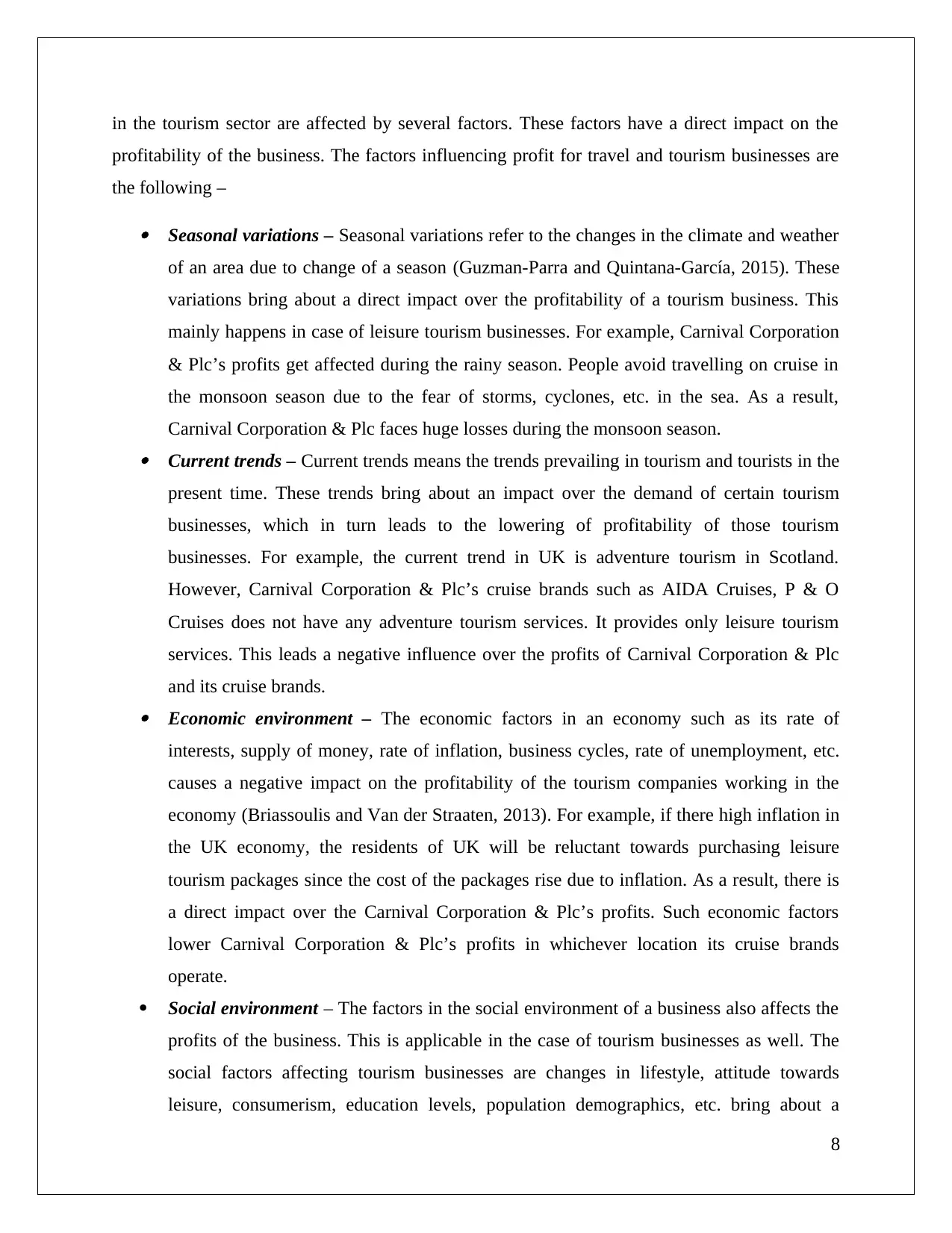
in the tourism sector are affected by several factors. These factors have a direct impact on the
profitability of the business. The factors influencing profit for travel and tourism businesses are
the following –
Seasonal variations – Seasonal variations refer to the changes in the climate and weather
of an area due to change of a season (Guzman-Parra and Quintana-García, 2015). These
variations bring about a direct impact over the profitability of a tourism business. This
mainly happens in case of leisure tourism businesses. For example, Carnival Corporation
& Plc’s profits get affected during the rainy season. People avoid travelling on cruise in
the monsoon season due to the fear of storms, cyclones, etc. in the sea. As a result,
Carnival Corporation & Plc faces huge losses during the monsoon season. Current trends – Current trends means the trends prevailing in tourism and tourists in the
present time. These trends bring about an impact over the demand of certain tourism
businesses, which in turn leads to the lowering of profitability of those tourism
businesses. For example, the current trend in UK is adventure tourism in Scotland.
However, Carnival Corporation & Plc’s cruise brands such as AIDA Cruises, P & O
Cruises does not have any adventure tourism services. It provides only leisure tourism
services. This leads a negative influence over the profits of Carnival Corporation & Plc
and its cruise brands. Economic environment – The economic factors in an economy such as its rate of
interests, supply of money, rate of inflation, business cycles, rate of unemployment, etc.
causes a negative impact on the profitability of the tourism companies working in the
economy (Briassoulis and Van der Straaten, 2013). For example, if there high inflation in
the UK economy, the residents of UK will be reluctant towards purchasing leisure
tourism packages since the cost of the packages rise due to inflation. As a result, there is
a direct impact over the Carnival Corporation & Plc’s profits. Such economic factors
lower Carnival Corporation & Plc’s profits in whichever location its cruise brands
operate.
Social environment – The factors in the social environment of a business also affects the
profits of the business. This is applicable in the case of tourism businesses as well. The
social factors affecting tourism businesses are changes in lifestyle, attitude towards
leisure, consumerism, education levels, population demographics, etc. bring about a
8
profitability of the business. The factors influencing profit for travel and tourism businesses are
the following –
Seasonal variations – Seasonal variations refer to the changes in the climate and weather
of an area due to change of a season (Guzman-Parra and Quintana-García, 2015). These
variations bring about a direct impact over the profitability of a tourism business. This
mainly happens in case of leisure tourism businesses. For example, Carnival Corporation
& Plc’s profits get affected during the rainy season. People avoid travelling on cruise in
the monsoon season due to the fear of storms, cyclones, etc. in the sea. As a result,
Carnival Corporation & Plc faces huge losses during the monsoon season. Current trends – Current trends means the trends prevailing in tourism and tourists in the
present time. These trends bring about an impact over the demand of certain tourism
businesses, which in turn leads to the lowering of profitability of those tourism
businesses. For example, the current trend in UK is adventure tourism in Scotland.
However, Carnival Corporation & Plc’s cruise brands such as AIDA Cruises, P & O
Cruises does not have any adventure tourism services. It provides only leisure tourism
services. This leads a negative influence over the profits of Carnival Corporation & Plc
and its cruise brands. Economic environment – The economic factors in an economy such as its rate of
interests, supply of money, rate of inflation, business cycles, rate of unemployment, etc.
causes a negative impact on the profitability of the tourism companies working in the
economy (Briassoulis and Van der Straaten, 2013). For example, if there high inflation in
the UK economy, the residents of UK will be reluctant towards purchasing leisure
tourism packages since the cost of the packages rise due to inflation. As a result, there is
a direct impact over the Carnival Corporation & Plc’s profits. Such economic factors
lower Carnival Corporation & Plc’s profits in whichever location its cruise brands
operate.
Social environment – The factors in the social environment of a business also affects the
profits of the business. This is applicable in the case of tourism businesses as well. The
social factors affecting tourism businesses are changes in lifestyle, attitude towards
leisure, consumerism, education levels, population demographics, etc. bring about a
8
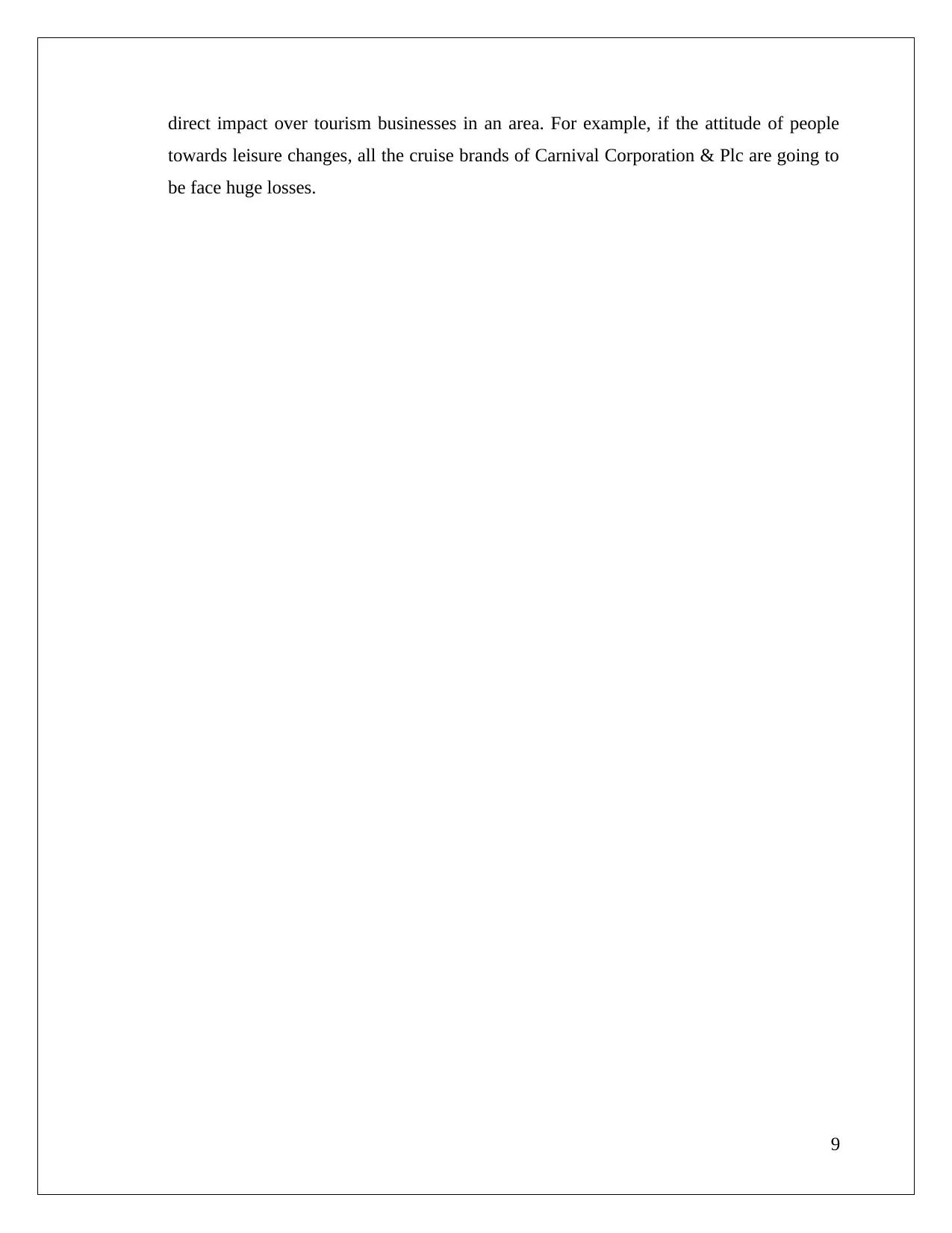
direct impact over tourism businesses in an area. For example, if the attitude of people
towards leisure changes, all the cruise brands of Carnival Corporation & Plc are going to
be face huge losses.
9
towards leisure changes, all the cruise brands of Carnival Corporation & Plc are going to
be face huge losses.
9
⊘ This is a preview!⊘
Do you want full access?
Subscribe today to unlock all pages.

Trusted by 1+ million students worldwide
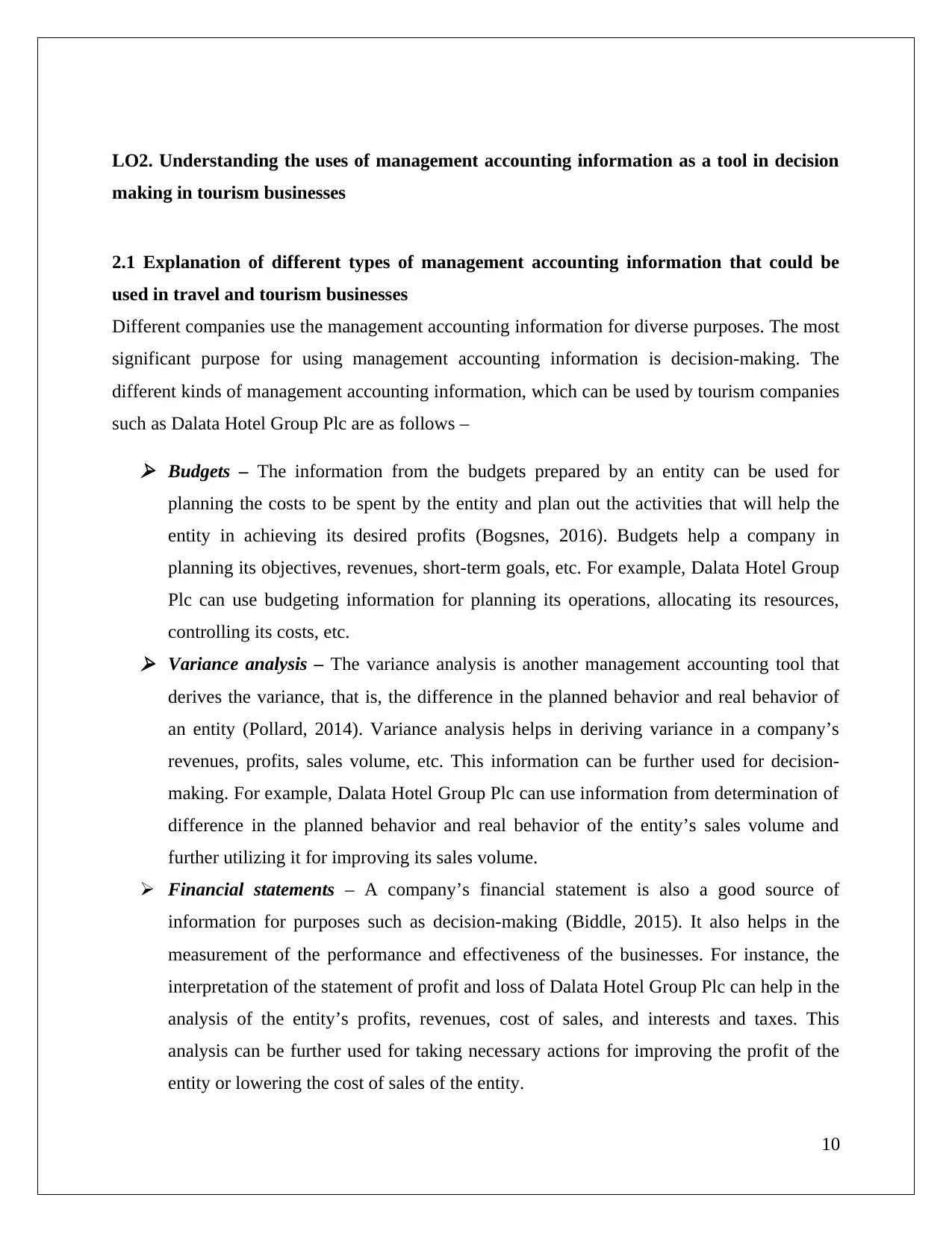
LO2. Understanding the uses of management accounting information as a tool in decision
making in tourism businesses
2.1 Explanation of different types of management accounting information that could be
used in travel and tourism businesses
Different companies use the management accounting information for diverse purposes. The most
significant purpose for using management accounting information is decision-making. The
different kinds of management accounting information, which can be used by tourism companies
such as Dalata Hotel Group Plc are as follows –
Budgets – The information from the budgets prepared by an entity can be used for
planning the costs to be spent by the entity and plan out the activities that will help the
entity in achieving its desired profits (Bogsnes, 2016). Budgets help a company in
planning its objectives, revenues, short-term goals, etc. For example, Dalata Hotel Group
Plc can use budgeting information for planning its operations, allocating its resources,
controlling its costs, etc. Variance analysis – The variance analysis is another management accounting tool that
derives the variance, that is, the difference in the planned behavior and real behavior of
an entity (Pollard, 2014). Variance analysis helps in deriving variance in a company’s
revenues, profits, sales volume, etc. This information can be further used for decision-
making. For example, Dalata Hotel Group Plc can use information from determination of
difference in the planned behavior and real behavior of the entity’s sales volume and
further utilizing it for improving its sales volume.
Financial statements – A company’s financial statement is also a good source of
information for purposes such as decision-making (Biddle, 2015). It also helps in the
measurement of the performance and effectiveness of the businesses. For instance, the
interpretation of the statement of profit and loss of Dalata Hotel Group Plc can help in the
analysis of the entity’s profits, revenues, cost of sales, and interests and taxes. This
analysis can be further used for taking necessary actions for improving the profit of the
entity or lowering the cost of sales of the entity.
10
making in tourism businesses
2.1 Explanation of different types of management accounting information that could be
used in travel and tourism businesses
Different companies use the management accounting information for diverse purposes. The most
significant purpose for using management accounting information is decision-making. The
different kinds of management accounting information, which can be used by tourism companies
such as Dalata Hotel Group Plc are as follows –
Budgets – The information from the budgets prepared by an entity can be used for
planning the costs to be spent by the entity and plan out the activities that will help the
entity in achieving its desired profits (Bogsnes, 2016). Budgets help a company in
planning its objectives, revenues, short-term goals, etc. For example, Dalata Hotel Group
Plc can use budgeting information for planning its operations, allocating its resources,
controlling its costs, etc. Variance analysis – The variance analysis is another management accounting tool that
derives the variance, that is, the difference in the planned behavior and real behavior of
an entity (Pollard, 2014). Variance analysis helps in deriving variance in a company’s
revenues, profits, sales volume, etc. This information can be further used for decision-
making. For example, Dalata Hotel Group Plc can use information from determination of
difference in the planned behavior and real behavior of the entity’s sales volume and
further utilizing it for improving its sales volume.
Financial statements – A company’s financial statement is also a good source of
information for purposes such as decision-making (Biddle, 2015). It also helps in the
measurement of the performance and effectiveness of the businesses. For instance, the
interpretation of the statement of profit and loss of Dalata Hotel Group Plc can help in the
analysis of the entity’s profits, revenues, cost of sales, and interests and taxes. This
analysis can be further used for taking necessary actions for improving the profit of the
entity or lowering the cost of sales of the entity.
10
Paraphrase This Document
Need a fresh take? Get an instant paraphrase of this document with our AI Paraphraser
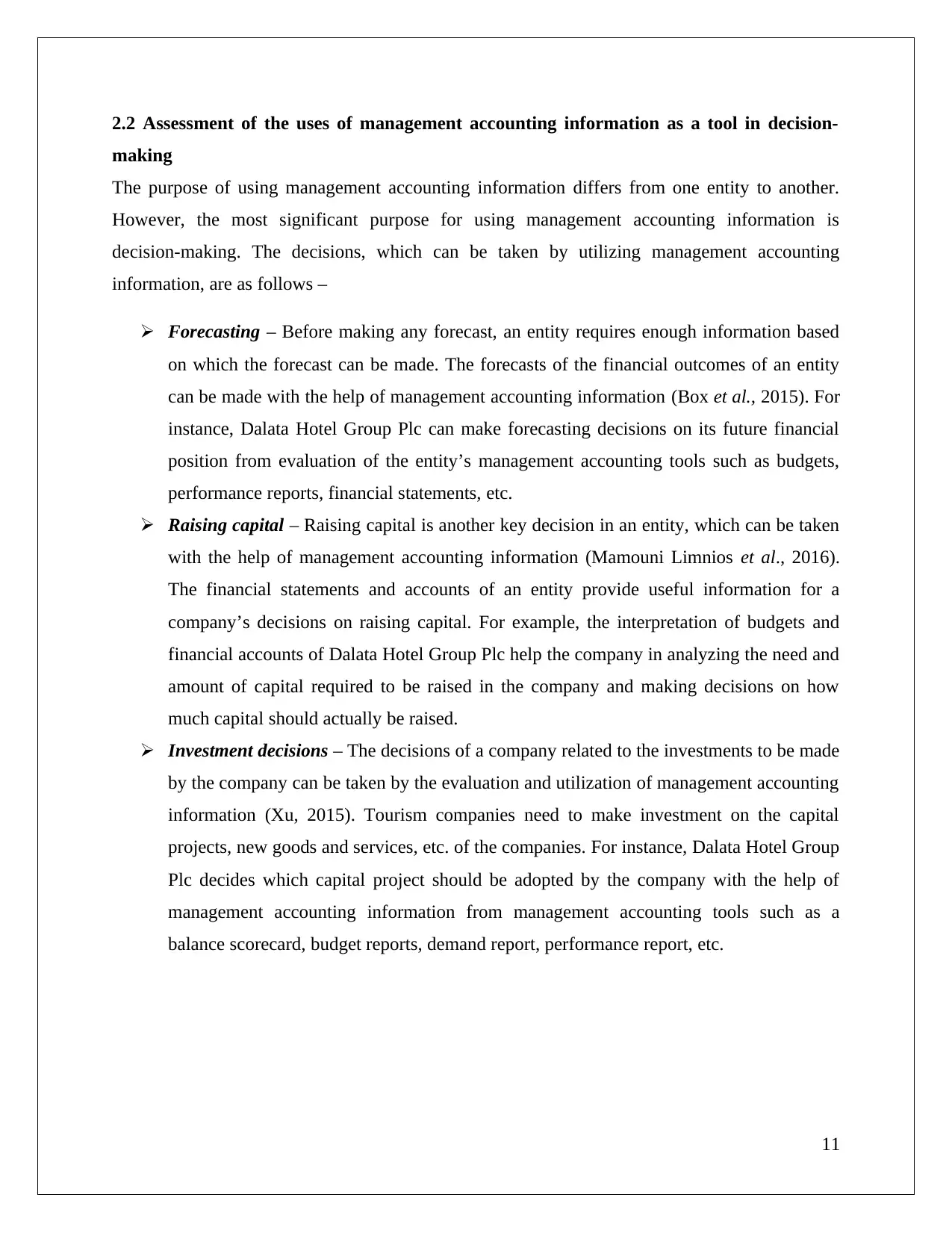
2.2 Assessment of the uses of management accounting information as a tool in decision-
making
The purpose of using management accounting information differs from one entity to another.
However, the most significant purpose for using management accounting information is
decision-making. The decisions, which can be taken by utilizing management accounting
information, are as follows –
Forecasting – Before making any forecast, an entity requires enough information based
on which the forecast can be made. The forecasts of the financial outcomes of an entity
can be made with the help of management accounting information (Box et al., 2015). For
instance, Dalata Hotel Group Plc can make forecasting decisions on its future financial
position from evaluation of the entity’s management accounting tools such as budgets,
performance reports, financial statements, etc.
Raising capital – Raising capital is another key decision in an entity, which can be taken
with the help of management accounting information (Mamouni Limnios et al., 2016).
The financial statements and accounts of an entity provide useful information for a
company’s decisions on raising capital. For example, the interpretation of budgets and
financial accounts of Dalata Hotel Group Plc help the company in analyzing the need and
amount of capital required to be raised in the company and making decisions on how
much capital should actually be raised.
Investment decisions – The decisions of a company related to the investments to be made
by the company can be taken by the evaluation and utilization of management accounting
information (Xu, 2015). Tourism companies need to make investment on the capital
projects, new goods and services, etc. of the companies. For instance, Dalata Hotel Group
Plc decides which capital project should be adopted by the company with the help of
management accounting information from management accounting tools such as a
balance scorecard, budget reports, demand report, performance report, etc.
11
making
The purpose of using management accounting information differs from one entity to another.
However, the most significant purpose for using management accounting information is
decision-making. The decisions, which can be taken by utilizing management accounting
information, are as follows –
Forecasting – Before making any forecast, an entity requires enough information based
on which the forecast can be made. The forecasts of the financial outcomes of an entity
can be made with the help of management accounting information (Box et al., 2015). For
instance, Dalata Hotel Group Plc can make forecasting decisions on its future financial
position from evaluation of the entity’s management accounting tools such as budgets,
performance reports, financial statements, etc.
Raising capital – Raising capital is another key decision in an entity, which can be taken
with the help of management accounting information (Mamouni Limnios et al., 2016).
The financial statements and accounts of an entity provide useful information for a
company’s decisions on raising capital. For example, the interpretation of budgets and
financial accounts of Dalata Hotel Group Plc help the company in analyzing the need and
amount of capital required to be raised in the company and making decisions on how
much capital should actually be raised.
Investment decisions – The decisions of a company related to the investments to be made
by the company can be taken by the evaluation and utilization of management accounting
information (Xu, 2015). Tourism companies need to make investment on the capital
projects, new goods and services, etc. of the companies. For instance, Dalata Hotel Group
Plc decides which capital project should be adopted by the company with the help of
management accounting information from management accounting tools such as a
balance scorecard, budget reports, demand report, performance report, etc.
11
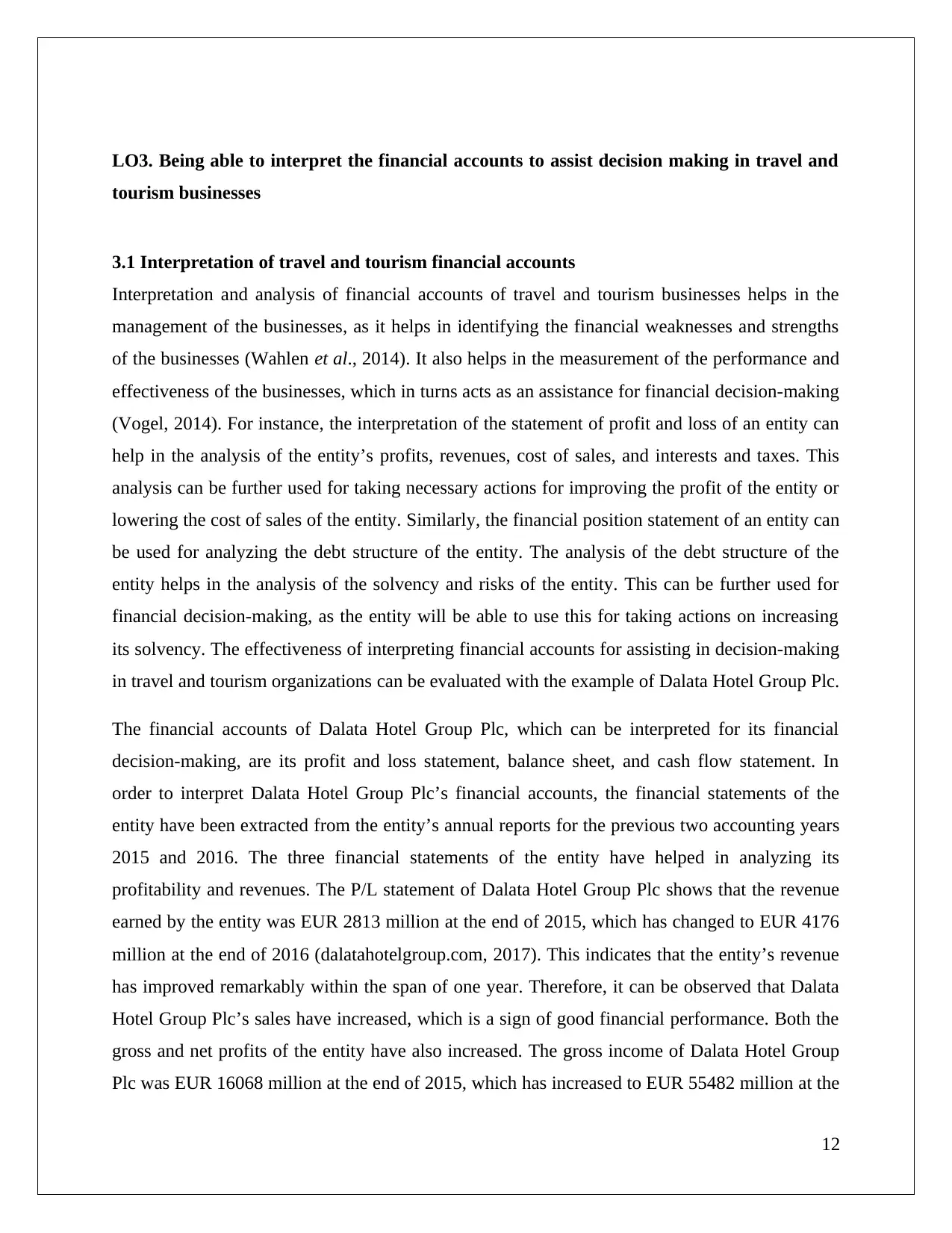
LO3. Being able to interpret the financial accounts to assist decision making in travel and
tourism businesses
3.1 Interpretation of travel and tourism financial accounts
Interpretation and analysis of financial accounts of travel and tourism businesses helps in the
management of the businesses, as it helps in identifying the financial weaknesses and strengths
of the businesses (Wahlen et al., 2014). It also helps in the measurement of the performance and
effectiveness of the businesses, which in turns acts as an assistance for financial decision-making
(Vogel, 2014). For instance, the interpretation of the statement of profit and loss of an entity can
help in the analysis of the entity’s profits, revenues, cost of sales, and interests and taxes. This
analysis can be further used for taking necessary actions for improving the profit of the entity or
lowering the cost of sales of the entity. Similarly, the financial position statement of an entity can
be used for analyzing the debt structure of the entity. The analysis of the debt structure of the
entity helps in the analysis of the solvency and risks of the entity. This can be further used for
financial decision-making, as the entity will be able to use this for taking actions on increasing
its solvency. The effectiveness of interpreting financial accounts for assisting in decision-making
in travel and tourism organizations can be evaluated with the example of Dalata Hotel Group Plc.
The financial accounts of Dalata Hotel Group Plc, which can be interpreted for its financial
decision-making, are its profit and loss statement, balance sheet, and cash flow statement. In
order to interpret Dalata Hotel Group Plc’s financial accounts, the financial statements of the
entity have been extracted from the entity’s annual reports for the previous two accounting years
2015 and 2016. The three financial statements of the entity have helped in analyzing its
profitability and revenues. The P/L statement of Dalata Hotel Group Plc shows that the revenue
earned by the entity was EUR 2813 million at the end of 2015, which has changed to EUR 4176
million at the end of 2016 (dalatahotelgroup.com, 2017). This indicates that the entity’s revenue
has improved remarkably within the span of one year. Therefore, it can be observed that Dalata
Hotel Group Plc’s sales have increased, which is a sign of good financial performance. Both the
gross and net profits of the entity have also increased. The gross income of Dalata Hotel Group
Plc was EUR 16068 million at the end of 2015, which has increased to EUR 55482 million at the
12
tourism businesses
3.1 Interpretation of travel and tourism financial accounts
Interpretation and analysis of financial accounts of travel and tourism businesses helps in the
management of the businesses, as it helps in identifying the financial weaknesses and strengths
of the businesses (Wahlen et al., 2014). It also helps in the measurement of the performance and
effectiveness of the businesses, which in turns acts as an assistance for financial decision-making
(Vogel, 2014). For instance, the interpretation of the statement of profit and loss of an entity can
help in the analysis of the entity’s profits, revenues, cost of sales, and interests and taxes. This
analysis can be further used for taking necessary actions for improving the profit of the entity or
lowering the cost of sales of the entity. Similarly, the financial position statement of an entity can
be used for analyzing the debt structure of the entity. The analysis of the debt structure of the
entity helps in the analysis of the solvency and risks of the entity. This can be further used for
financial decision-making, as the entity will be able to use this for taking actions on increasing
its solvency. The effectiveness of interpreting financial accounts for assisting in decision-making
in travel and tourism organizations can be evaluated with the example of Dalata Hotel Group Plc.
The financial accounts of Dalata Hotel Group Plc, which can be interpreted for its financial
decision-making, are its profit and loss statement, balance sheet, and cash flow statement. In
order to interpret Dalata Hotel Group Plc’s financial accounts, the financial statements of the
entity have been extracted from the entity’s annual reports for the previous two accounting years
2015 and 2016. The three financial statements of the entity have helped in analyzing its
profitability and revenues. The P/L statement of Dalata Hotel Group Plc shows that the revenue
earned by the entity was EUR 2813 million at the end of 2015, which has changed to EUR 4176
million at the end of 2016 (dalatahotelgroup.com, 2017). This indicates that the entity’s revenue
has improved remarkably within the span of one year. Therefore, it can be observed that Dalata
Hotel Group Plc’s sales have increased, which is a sign of good financial performance. Both the
gross and net profits of the entity have also increased. The gross income of Dalata Hotel Group
Plc was EUR 16068 million at the end of 2015, which has increased to EUR 55482 million at the
12
⊘ This is a preview!⊘
Do you want full access?
Subscribe today to unlock all pages.

Trusted by 1+ million students worldwide
1 out of 20
Related Documents
Your All-in-One AI-Powered Toolkit for Academic Success.
+13062052269
info@desklib.com
Available 24*7 on WhatsApp / Email
![[object Object]](/_next/static/media/star-bottom.7253800d.svg)
Unlock your academic potential
Copyright © 2020–2025 A2Z Services. All Rights Reserved. Developed and managed by ZUCOL.



